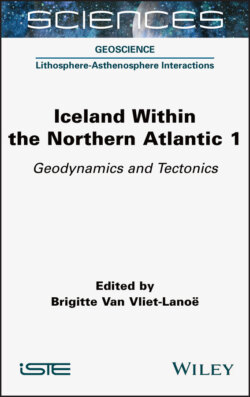Читать книгу Iceland Within the Northern Atlantic, Volume 1 - Группа авторов - Страница 22
1.3.1. Seismicity
ОглавлениеWhile seismic activity in Iceland underlines all plate boundaries (Figure 1.7), it is less continuous and less strong in the rift and is mainly concentrated in the transform zones that connect the active rift to the offshore segments of the ridge to the north and south of the island.
Figure 1.7. Seismicity in Iceland recorded by the SIL network between 1994 and 2007 (modified from Jakobsdóttir 2008). Volcanic systems according to Einarsson and Sæmundsson (1987). EVZ: East Volcanic Zone; NVZ: North Volcanic Zone; WVZ: West Volcanic Zone; ZFT: Tjörnes Fracture Zone; SISZ: South Iceland Seismic Zone
The Icelandic Rift corresponds to the onshore extensions of two segments of the North-MAR, the Reykjanes Ridge to the south and the Kolbeinsey Ridge to the north (Figures 1.2 and 1.5). It has three branches (Figure 1.7), all offset eastward from the axis of the North-MAR. These branches of the rift consist of fissure swarms associated with active central volcanoes, a significant portion of which are located beneath the major glaciers of the island; they can be guessed from the ice-free topographic map (Figure 1.2(b)). In the rift, seismicity is strongly linked to the functioning of magmatic systems (Figure 1.7). This seismicity of volcanic origin and the volcanism itself (for example, the recent eruption of the Bárðarbunga volcano and its large flow of basaltic lava) testify to an important active magmatism supposed to be fed by the Icelandic hot spot.
The shift of the Icelandic rift with respect to the axis of the North-MAR is accommodated by two transform zones, the South Iceland Seismic Zone (SISZ) to the south and the Tjörnes Fracture Zone (TFZ) to the north. Both are inherited from an older history, that of the opening of the Atlantic (Chapter 3) and linked to the “rift jump” phenomenon (Chapter 2). It is in these two transform zones that seismicity is the most sustained (Figure 1.7) with both quasi-permanent microseismicity and major recurrent seismicity whose magnitude can exceed 7 (section 2.2.1).
The disposition of the two rift branches in the south of the island (WVZ and EVZ) resembles that of the overlapping spreading centers (OSC) described on fast-spreading ridges, rather than that of a true transform zone. Nevertheless, the associated seismicity characterizes well the left-lateral transform motion of the SISZ, connecting the EVZ to the Reykjanes Ridge. At present, the two branches of the rift do not have the same level of activity, and the WVZ accommodates only a small part of the extension; the question of whether this present low activity is representative of the last thousands or millions of years will be discussed in Chapter 2.
